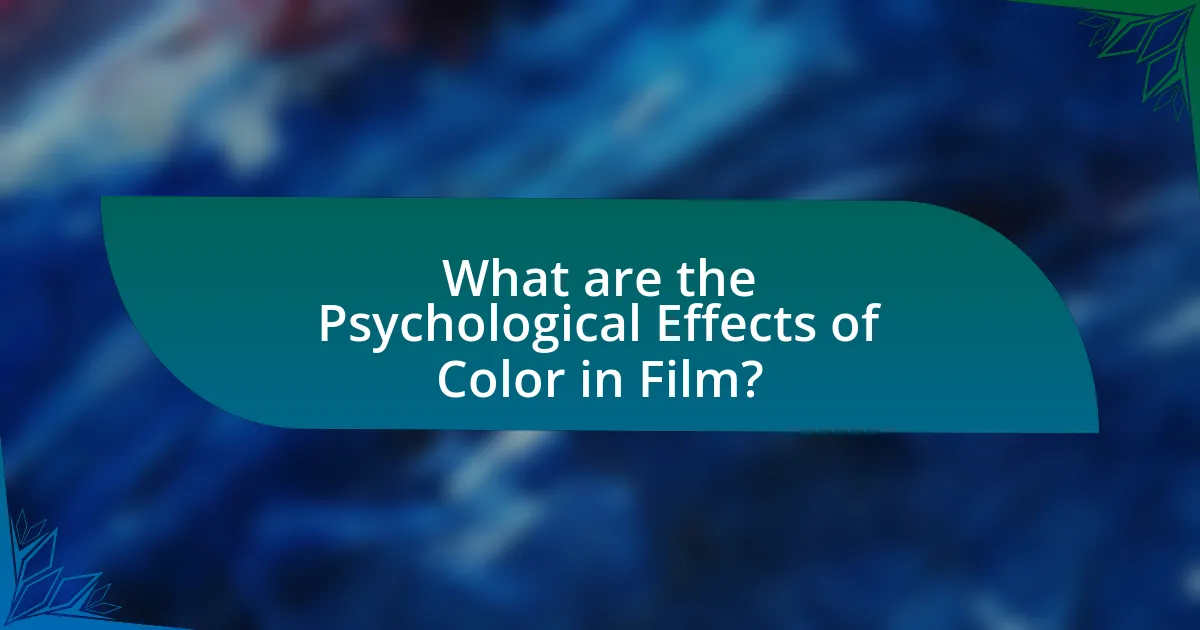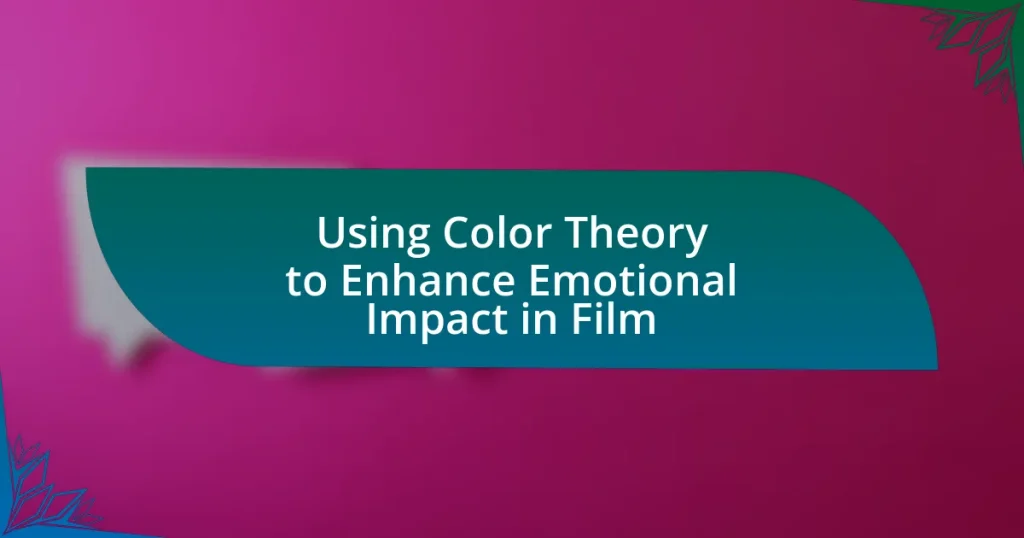Color theory in film is a critical aspect that filmmakers utilize to convey emotions, set moods, and enhance storytelling. The article explores how color selection influences emotional responses, character development, and narrative flow, supported by psychological research on color perception. It outlines the basic principles of color theory relevant to filmmaking, discusses the implications of color grading in post-production, and highlights notable films that effectively apply these concepts. Additionally, it addresses common challenges filmmakers face in maintaining color consistency and offers practical tips for implementing color theory in their projects.

What is Color Theory in Film?
Color theory in film refers to the use of color to convey emotions, set the mood, and enhance storytelling. Filmmakers strategically select color palettes to evoke specific feelings and reactions from the audience, influencing their perception of characters and events. For example, warm colors like red and orange can create feelings of warmth or aggression, while cool colors like blue and green often evoke calmness or sadness. This application of color theory is supported by psychological studies that show color can significantly affect human emotions and behavior, making it a powerful tool in visual storytelling.
How does color theory influence emotional responses in film?
Color theory significantly influences emotional responses in film by utilizing specific colors to evoke particular feelings and moods. For instance, warm colors like red and orange can create feelings of excitement or anger, while cool colors such as blue and green often evoke calmness or sadness. Research indicates that color can affect viewers’ psychological states; a study published in the Journal of Experimental Psychology found that colors can alter emotional perception and memory recall. This demonstrates that filmmakers strategically use color palettes to enhance storytelling and manipulate audience emotions effectively.
What are the basic principles of color theory relevant to filmmaking?
The basic principles of color theory relevant to filmmaking include the color wheel, color harmony, and the psychological effects of colors. The color wheel organizes colors into primary, secondary, and tertiary categories, providing a framework for understanding color relationships. Color harmony refers to the aesthetically pleasing combinations of colors, such as complementary, analogous, and triadic schemes, which filmmakers use to create visual balance and mood. The psychological effects of colors influence audience emotions; for example, red can evoke passion or danger, while blue may convey calmness or sadness. These principles guide filmmakers in crafting visual narratives that resonate emotionally with viewers.
How do colors evoke specific emotions in viewers?
Colors evoke specific emotions in viewers through psychological associations and cultural meanings. For instance, red often signifies passion or danger, while blue is associated with calmness and sadness. Research indicates that colors can influence mood and perception; a study published in the journal “Color Research and Application” by Andrew Elliot and Markus Maier found that warm colors like red and yellow can increase feelings of warmth and excitement, whereas cool colors like blue and green can promote tranquility and relaxation. This emotional response is utilized in film to enhance storytelling and character development, effectively guiding audience reactions and engagement.
Why is color selection crucial in film production?
Color selection is crucial in film production because it significantly influences the audience’s emotional response and narrative interpretation. Colors evoke specific feelings and associations; for instance, red can symbolize passion or danger, while blue often conveys calmness or sadness. Research indicates that color can affect mood and perception, as demonstrated in studies like those by Andrew Elliot and Markus Maier, which show that warm colors can enhance feelings of warmth and comfort, while cool colors can induce feelings of sadness or detachment. Therefore, filmmakers strategically use color to enhance storytelling, guide viewer emotions, and create a cohesive visual experience that aligns with the film’s themes.
What role does color play in character development?
Color plays a significant role in character development by influencing audience perception and emotional response. In film, specific colors are often associated with particular traits or emotions; for example, red can signify passion or anger, while blue may represent calmness or sadness. This association helps to visually communicate a character’s internal state and evolution throughout the narrative. Research indicates that color can evoke psychological responses, as demonstrated in studies like those by Andrew Elliot and Markus Maier, which show that colors can affect mood and behavior. Thus, filmmakers strategically use color to enhance character depth and audience engagement, making it a crucial element in storytelling.
How can color enhance storytelling and narrative flow?
Color enhances storytelling and narrative flow by evoking emotions, establishing mood, and guiding audience attention. For instance, warm colors like red and orange can create feelings of excitement or urgency, while cool colors like blue and green often evoke calmness or sadness. Research indicates that color can influence viewers’ emotional responses; a study published in the journal “Color Research and Application” found that colors significantly affect mood and perception, impacting how narratives are received. By strategically using color palettes, filmmakers can reinforce themes and character arcs, ensuring that visual storytelling aligns with the emotional journey of the narrative.

What are the Psychological Effects of Color in Film?
The psychological effects of color in film significantly influence audience emotions and perceptions. Colors evoke specific feelings; for instance, red can symbolize passion or danger, while blue often conveys calmness or sadness. Research indicates that color can affect mood and behavior, with studies showing that warm colors tend to energize viewers, while cool colors can create a sense of tranquility. For example, a study published in the Journal of Experimental Psychology found that colors can alter emotional responses, impacting how viewers interpret scenes and characters. Thus, filmmakers strategically use color to enhance storytelling and emotional engagement, making it a crucial element in cinematic experiences.
How do different colors affect audience perception?
Different colors significantly affect audience perception by evoking specific emotions and associations. For instance, red often conveys passion or urgency, while blue typically represents calmness and trust. Research by the Institute for Color Research indicates that people make a subconscious judgment about a person, environment, or product within 90 seconds of initial viewing, with color influencing 62-90% of that assessment. This demonstrates that color choices in film can shape viewers’ emotional responses and overall engagement with the narrative.
What emotions are commonly associated with primary colors?
Red is commonly associated with emotions such as passion, anger, and love. This strong color often evokes feelings of excitement and urgency, making it a powerful tool in visual storytelling. Blue typically conveys calmness, sadness, and tranquility, often used to create a serene atmosphere or to depict melancholy. Yellow is linked to happiness, optimism, and energy, frequently utilized to evoke feelings of cheerfulness and warmth. These associations are grounded in psychological studies, such as those by Andrew Elliot and Markus Maier, which demonstrate how colors influence emotional responses and perceptions.
How do cultural differences influence color perception in film?
Cultural differences significantly influence color perception in film by shaping the emotional and symbolic meanings associated with specific colors. For instance, in Western cultures, the color white is often linked to purity and weddings, while in many Eastern cultures, it is associated with mourning and funerals. This divergence affects how audiences interpret visual narratives, as filmmakers must consider these cultural contexts to evoke the desired emotional responses. Research by Paul Ekman on cross-cultural emotions indicates that color associations can vary widely, impacting audience engagement and interpretation of film content.
What are the implications of color grading in post-production?
Color grading in post-production significantly influences the emotional tone and visual storytelling of a film. It allows filmmakers to manipulate colors to evoke specific feelings, enhance mood, and create a cohesive visual style that aligns with the narrative. For instance, warm tones can evoke feelings of comfort or nostalgia, while cooler tones may convey sadness or detachment. Research indicates that color can affect audience perception and emotional response; a study published in the Journal of Experimental Psychology found that colors can influence mood and behavior, demonstrating the psychological impact of color choices in visual media. Thus, effective color grading is essential for enhancing the emotional impact of a film and guiding audience reactions.
How does color grading alter the mood of a scene?
Color grading significantly alters the mood of a scene by manipulating the hues, saturation, and contrast to evoke specific emotional responses. For instance, warm colors like reds and oranges can create feelings of warmth, passion, or urgency, while cool colors such as blues and greens often convey calmness, sadness, or detachment. Studies in color psychology indicate that colors can influence viewers’ perceptions and emotions; for example, a 2015 study published in the journal “Color Research and Application” found that color temperature affects emotional interpretation, with warmer tones being associated with positive emotions and cooler tones with negative ones. Thus, effective color grading can enhance storytelling by aligning visual elements with the intended emotional impact.
What techniques are used in color grading to enhance emotional impact?
Color grading techniques that enhance emotional impact include the use of color palettes, contrast adjustments, and saturation levels. Color palettes, such as warm tones for comfort or cool tones for sadness, directly influence audience emotions. Contrast adjustments can create dramatic tension or highlight specific elements, guiding viewer focus and emotional response. Additionally, manipulating saturation levels can evoke feelings; for instance, desaturated colors often convey bleakness, while vibrant colors can elicit joy or excitement. These techniques are supported by studies in color psychology, which demonstrate that specific colors and their combinations can significantly affect mood and perception in visual media.

How is Color Theory Applied in Film Examples?
Color theory is applied in film through the strategic use of color palettes to evoke specific emotions and enhance storytelling. For instance, in “The Grand Budapest Hotel,” director Wes Anderson employs a pastel color scheme to create a whimsical and nostalgic atmosphere, which aligns with the film’s themes of memory and loss. Similarly, in “Schindler’s List,” Steven Spielberg uses a predominantly black-and-white palette with selective splashes of color, such as the red coat of a young girl, to emphasize the horror of the Holocaust and draw attention to critical narrative elements. These examples illustrate how filmmakers utilize color to influence audience perception and emotional response, reinforcing the narrative’s impact.
What are some notable films that effectively use color theory?
Notable films that effectively use color theory include “The Grand Budapest Hotel,” “Hero,” and “The Sixth Sense.” “The Grand Budapest Hotel” employs a pastel color palette to evoke nostalgia and whimsy, enhancing the film’s comedic and dramatic elements. “Hero” utilizes distinct color schemes for each storyline, symbolizing different emotions and themes, which deepens the narrative complexity. “The Sixth Sense” uses a muted color palette to create a sense of unease and tension, aligning with the film’s psychological themes. Each of these films demonstrates how color theory can significantly influence audience perception and emotional response.
How does the use of color in these films enhance their emotional impact?
The use of color in films enhances their emotional impact by evoking specific feelings and setting the tone for scenes. For instance, warm colors like red and orange can create a sense of passion or urgency, while cool colors such as blue and green often evoke calmness or sadness. Research indicates that color can influence viewers’ emotional responses; a study published in the journal “Color Research and Application” found that colors significantly affect mood and perception, demonstrating that filmmakers strategically use color palettes to align audience emotions with narrative themes. This intentional application of color theory allows filmmakers to deepen the audience’s connection to the story and characters, ultimately amplifying the overall emotional experience.
What lessons can filmmakers learn from these examples?
Filmmakers can learn that color theory significantly influences audience emotions and perceptions. By strategically using color palettes, filmmakers can evoke specific feelings, enhance storytelling, and create memorable visual experiences. For instance, studies show that warm colors like red and orange can evoke feelings of warmth and excitement, while cool colors like blue and green can create calmness or sadness. This understanding allows filmmakers to manipulate emotional responses effectively, as seen in films like “The Sixth Sense,” where color is used to signify different emotional states and plot developments.
How can filmmakers implement color theory in their projects?
Filmmakers can implement color theory in their projects by strategically selecting color palettes that evoke specific emotions and enhance storytelling. For instance, warm colors like red and orange can create feelings of excitement or anger, while cool colors such as blue and green can evoke calmness or sadness. Research indicates that colors can significantly influence audience perception and emotional response; for example, a study published in the Journal of Experimental Psychology found that color can affect mood and behavior, reinforcing the importance of color choices in film. By understanding the psychological effects of colors, filmmakers can effectively use color grading and set design to align visual elements with the narrative, thereby deepening the emotional impact of their films.
What practical tips can filmmakers use to choose colors effectively?
Filmmakers can choose colors effectively by understanding color theory and its emotional implications. Utilizing the color wheel, filmmakers can select complementary colors to create visual harmony or contrasting colors to evoke tension. For instance, blue often conveys calmness, while red can signify passion or danger. Additionally, filmmakers should consider the psychological effects of colors; studies show that colors can influence viewer emotions and perceptions, such as how warm colors can create feelings of warmth and comfort, while cool colors can evoke sadness or detachment. By strategically applying these principles, filmmakers can enhance storytelling and emotional resonance in their work.
How can filmmakers test color choices during production?
Filmmakers can test color choices during production by utilizing color swatches, digital color grading tools, and on-set lighting adjustments. Color swatches allow filmmakers to visualize how different colors interact with each other and the overall scene. Digital color grading tools enable real-time adjustments and previews of color palettes, helping to assess emotional impact. On-set lighting adjustments can also influence how colors appear on camera, allowing filmmakers to experiment with various lighting conditions to achieve the desired effect. These methods are supported by studies showing that color significantly affects audience perception and emotional response, reinforcing the importance of careful color selection in filmmaking.
What are common challenges in using color theory in film?
Common challenges in using color theory in film include achieving visual coherence, ensuring color symbolism aligns with narrative themes, and managing audience perception. Visual coherence can be difficult as filmmakers must balance a diverse color palette while maintaining a unified aesthetic throughout the film. Additionally, color symbolism may not universally resonate; for instance, red can signify love in one culture but danger in another, complicating the intended emotional impact. Furthermore, audience perception can vary widely, leading to misinterpretations of color choices, which can detract from the film’s emotional message. These challenges highlight the complexity of effectively employing color theory in cinematic storytelling.
How can filmmakers overcome issues related to color consistency?
Filmmakers can overcome issues related to color consistency by utilizing color grading techniques during post-production. This process involves adjusting the colors in the footage to ensure uniformity across different scenes, which is essential for maintaining the visual coherence of the film. For instance, using software like DaVinci Resolve or Adobe Premiere Pro allows filmmakers to match colors from various shots, ensuring that lighting conditions and camera settings do not create discrepancies. Additionally, establishing a color palette before filming can guide the cinematography and set design, further enhancing consistency. Studies have shown that films with consistent color schemes can evoke stronger emotional responses from audiences, reinforcing the importance of this practice in filmmaking.
What mistakes should filmmakers avoid when applying color theory?
Filmmakers should avoid using color theory inconsistently, as this can confuse the audience and dilute the intended emotional impact. Consistency in color palettes helps convey specific themes and emotions effectively; for example, using warm colors can evoke feelings of comfort or passion, while cool colors can suggest calmness or sadness. Additionally, filmmakers should not ignore the cultural significance of colors, as different cultures may interpret colors differently, potentially leading to miscommunication of the intended message. Research indicates that color perception is influenced by cultural context, which can affect audience reception. Lastly, filmmakers should refrain from over-saturating scenes with color, as excessive brightness can overwhelm viewers and detract from the narrative. Balancing color intensity is crucial for maintaining focus on the story and characters.

